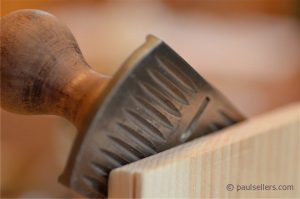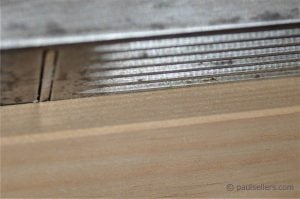Questions answered – On corrugated soles
Question:
Hi Paul,
You mentioned corrugated soles in your recent blog. What’s wrong with corrugated soles?
Dan
Answer:

We unsuspecting woodworkers come along and are wowed by a slither of wood emerging from the throat of a plane because we never got that with our planes at school when we were 13 and we didn’t really understand why we had to be there. So, an engineer, a guy called Steers, invented a plane the sole of which received strips of lignum vitae or greenheart into the sole of the plane. Well over 60% of the sole was this self-oiling wood, which on its own would glide over the surface of a board like a swan on a lake. This aspect of the plane worked and worked well, the other parts didn’t. It was an attempt ,like the corrugated sole, to help us woodworkers so that they could sell more planes ad we would have the burden of wood-grabbing surface-sucking planes lifted from us.

The corrugated sole was produced in Bailey pattern planes for a period with the intention of reducing the surface area of the sole to further reduce the friction of the plane on the surface being planed. Indeed it does do that, but it also damages corners and edges of wood when you start to plane angles such as chamfers or form bullnoses to things such as box lids, window sills and stair treads. The transition from wooden bodied planes was a difficult trial for those who were bent on engineering cast metal planes. Workers of wood, then, in those days now gone, knew the benefit of using all wooden planes and were hard to convince that all metal was better because it really wasn’t. Until you have used one of Phil Edwards planes, you have never lived. 
It stands to reason then that if plane users, not salesmen selling planes, rejected the lightweight #4, #4 1/2, #5 and #5 1/2 planes because they “stuck” to the wood then they would definitely have rejected heavyweight planes proffered today because all the more these planes stick with even greater stickierness regardless of whether they are made in the UK, USA or China. Wider planes stick even more and so too longer planes. Stick to lightweight planes if you are to use planes at the bench. They may not match wood, but they are light and easy to use and they will do what any heavy plane will do.


I agree Paul. Corrugated soles are/can be a nightmare when finishing surfaces with them and have a habit of grabbing fine shavings, which – in turn – can and will ruin a surface if one isn’t careful. I much prefer planes with more heft to them and although I have a couple of planes with corrugated soles among my kit, I tend to keep the troublemakers relegated to rough dimensioning and well away from finishing.
Paul,
Great blog as usual. In your blog you mention the benefit of using all wooden planes. Yet in your demonstrations, classes u teach and videos, I don’t believe I’ve seen you use one. What made craftsmen convert to metal planes and do u own and use wooden planes on a regular basis?
Paul, I would both know the answer this question as well. Perhaps a future blog post?
Not sure what the question is Damien.
On the Woodworking Masterclasses site, he demonstrates several Sandusky planes which he uses.
Sure goes faster when flattening the sole of an old plane – when they are corrugated. Especially true of long planes.
I also agree about there being little value in corrugated soles. My current smoothing plane, a WWII-era Stanley 4 /2, has a corrugated sole, and it’s the only part about the plane I don’t like. I haven’t really had problems with shavings sticking in the grooves, but as you say, the grooves make trouble when chamfering an edge or otherwise working on surfaces that aren’t already flat. So I typically use my jointer plane or my block plane to break edges and leave the smoother for actual smoothing tasks. Perhaps one day I’ll replace it with a flat-soled plane, but my wife paid $2.50 for it at a rummage sale, so I suppose I can’t complain too very much.
I’m also not convinced that the corrugations actually reduce friction when planing, as the marketing propaganda claimed. If I remember my physics correctly, friction is increased by the weight (or downward pressure) on a surface, not by surface area per se. I may be misremembering the principle, but I think the corrugations merely concentrate the friction into a smaller surface area rather than actually reducing it.
I am new to woodworking, and trying to buy old Stanley planes. Prices of flat sole on eBay are expensive, buy some corrugated sole are more affordable. To try to save some money, would it be reasonable to get a corrugated sole on any planes for which I would need to smooth the wood afterwards? Or, am I just asking for trouble, and should focus my money on all flat sole planes? Any recommendations appreciated.
I just looked on eBay and the #4 and #5 sell here Buy it Now for £25 to £40 and so will go for less than that bidding. That’s not very much for a good lifetime plane really. And they do last for that long. Corrugated soles are OK but do cause problems. Look up a post on my blog for more info on this, B. Use the search box. I think there are too many irksome things with corrugated soles. Best regards, Paul
Thank you for your guidance. I live in the US, and most of the #4 and #5 Stanley planes auction out in the US dollar based 40s to 50s before shipping. Shipping adds10-20. I will just pay the higher price, as it seems close to the higher end of what you saw in pounds. I would rather have proper tools than the wrong tools.
Again, thank you for your guidance, and for making all of the you tube videos. I am learning a lot watching your videos, and have many many projects I am looking forward to making!
You are providing a great public service by making this information available to the general public.
I am cleaning up & restoring a old bailey #6 Plane that was great grandpaws..
It has the corrugated sole & will be used mostly for jointing..
I see no reason why it couldn’t work as well as long as the grooves are kept clean..
This is my largest plane & have 4 smaller metal Stanley’s & 5 old wooden planes from gramp’s old tool chest..
It will work fine. It’s just an occasional frustration when a shaving does grab at the last minute occasionally but you can live with that.
I’m excited that I picked up a Bedrock 604 today for 50 cents! For this price I will deal with the corrugated sole. Hopefully, I will find a smooth bottom Bailey too. 🙂
Thanks Paul.
I am grateful for all your help and instruction.
I Just bought a Stanly Bailey no. 7 coragated at a swap meet for $15 , had to restore it , it came out like new but from all your negative comments should I keep it or get rid of it ?
I’d keep it and use it. I like the way they look and they do work fine they just have to be worked with differently.
Thanks ,Paul. I have been enjoying your videos for a while now.
I enjoy reading your blog and it paid off. I was just about to bid on a #4C on EBay. I’ll keep waiting for the right #4 smooth plane!
Thanks for the insight Mr. Sellers. I’m helping a friend by selling a few nice items that her father used years ago and one of them is a # 6 Bailey plane that is not corrugated and in just a little better shape than my own #6 corrugated Bailey. I’ve been torn over swapping them since it doesn’t matter much which one I sell, and even considered buying hers and having two, though really, who needs two of the same plane? I believe I’ll sell the corrugated one as it will seem more exotic and enticing, and put the other to good use.
Love your videos, but need to stop watching and do some woodworking instead!